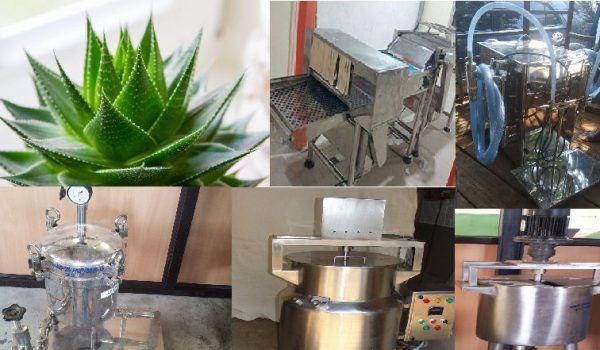Project Report For Aloe Vera Processing Plant
Introduction
Project Report For Aloe Vera Processing Plant is as follows.
For thousands of years, aloe vera has been utilized for therapeutic purposes. Its use has been documented in ancient societies such as India, Egypt, Greece, Rome, and China. The Egyptians regarded aloe vera as the plant of immortality during biblical times. The Chinese referred to it as an elixir of youth. The aloe vera plant is known by many other names, including burn plant, first aid plant, and medicine plant. Its name is most likely derived from the Arabic word “Alloeh,” which means “bright and bitter substance.”
Aloe vera is a cactus-like xerophyte with prickly leaves. It’s a clump-forming perennial with a thick fibrous root that produces big basal leaves, usually 12-16 per plant and weighing up to 1.5 kg when mature. The plant matures at about 4 years of age and lives for about 12 years. The leaves can grow to be up to 0.5 m long and 8-10 cm wide at the base, tapering to a tip with saw-like teeth along the margins. The plant appears slightly concave on the adaxial surface and notably convex on the lower abaxial surface in a transverse section.
Natural cosmetic products are made with aloe vera, wild apricot oil, and artemisia, among other natural ingredients. Aloe-Vera has been employed in the pharmaceutical business to make ointments and cosmetic items such as creams, soaps, and lotions. Aloe Vera processing is blending, crushing, and boiling the juice of the Aloe Vera leaf and other elements to create a variety of products. The extracted juice is combined with other ingredients to create pharmacological and cosmetic products.

Processing Of Aloe Vera Processing Plant
The leaves of aloe vera are taken from mature plants that are three to four years old. It is critical to select leaves that are healthy and free of sickness or injury. The collected leaves are thoroughly washed to remove any dirt or contaminants on the exterior surface. The aloe vera leaf’s outer green rind is carefully removed to reveal the gel-filled interior leaf. This can be done either manually or with the assistance of mechanized machinery.
The gel is then carefully removed from the inner leaf using techniques such as scraping and squeezing. Special care is needed to ensure that only the gel is removed and that the yellow latex layer beneath the rind is avoided, as it can be bitter and potentially irritate the skin. Typically, the extracted gel is filtered to remove any leftover contaminants or solid particles. This phase aids in the creation of a clear and pure gel.
When aloe vera gel is exposed to air, it oxidises and loses its therapeutic characteristics. Stabilisers or preservatives can be added to the gel to prevent this. This procedure guarantees that the gel’s purity and efficacy are maintained over time. The aloe vera gel is then packaged in appropriate containers such as bottles or tubes. On the packaging, proper labelling and instructions are provided to advise consumers about its use and storage.
Market Potential Of Aloe Vera Processing Plant
The Aloe Vera Market was worth USD 735.88 million in 2022 and is expected to reach USD 1271.47 million by 2030, increasing at a 6.8% CAGR from 2023 to 2030.
Aloe Vera has numerous benefits and is used in a variety of industries such as food, beverages, cosmetics, and medications. Numerous studies have also revealed that Aloe Vera is useful in a variety of conditions, such as tooth and gum problems, constipation, diabetes-induced foot ulcers, antibacterial properties, UV radiation protection, skin issues, and so on. Aside from its current use,
The therapeutic characteristics of aloe vera drive the worldwide aloe vera market, which generates demand for the product in a variety of industries. Thailand is the world’s biggest producer of aloe vera, accounting for more than a third of total global production. On the other hand, Asia Pacific is the product’s greatest consumer, accounting for the bulk of total global consumption.
With rising urbanization, the plantation process deteriorates, resulting in decreased aloe vera yield while increasing demand for aloe vera. Because manufacturers are unable to meet client demand, the expansion of the aloe vera market is hampered. Several manufacturing operations were shut down as a result of lockdowns following the pandemic epidemic, resulting in lower productivity. Several new chemical and processed alternatives to aloe vera have emerged in the market, posing a threat to the market’s growth.
Project Report Sample On Aloe Vera Processing Plant
Need Help?
Create 100% Bankable Project Report

